Last weekend I had my first Virgin America flight to San Francisco; a flight that was given to me for free through a joint campaign between Virgin America and Klout because of my ‘influence‘ on Twitter. Now, I have already written a post with my opinions as to why this particular campaign was met with a lot of criticism on and off Twitter, and the areas where I think the campaign struggled. Once I sat down with Klout, we quickly realized that many of those areas could be rolled up into single issue: communication.
Klout was gracious enough to give an open invite to the winners of the campaign to stop by their office in San Francisco (where they have some great company in Twitter, Bebo and others — I met Ev in the hallway, a true San Francisco celebrity sighting), and with my interest in emerging technologies, I jumped at the chance. We went over the issues that I listed in my post, and while I could tell they certainly weren’t pleased with me, they gave me some truly valuable insight into not only the selection process for this particular campaign, but also their business.
What the Client Wants
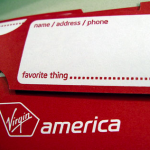 All marketing campaigns have a target demographic as determined by the client. In this case it was Virgin America and they wanted people who not only had influence, but were aligned with their brand and this particular campaign. Klout was the tool that took the data we pump daily into Twitter (think of all that data!) and used it to categorize and profile each and everyone one of us, allowing their client to pick and choose what type of person would be given a flight. Yes, the client wanted ‘influencers’ (anyone else hate that word yet?), but they also wanted people who spoke about the various destinations, among many other variables that they deemed important. Normally, it is rare that the target demographic for a campaign is so heavily questioned, but when dealing with a large number of users who like to talk a lot, it’s more than likely to be put under the microscope and heavily scrutinized.
All marketing campaigns have a target demographic as determined by the client. In this case it was Virgin America and they wanted people who not only had influence, but were aligned with their brand and this particular campaign. Klout was the tool that took the data we pump daily into Twitter (think of all that data!) and used it to categorize and profile each and everyone one of us, allowing their client to pick and choose what type of person would be given a flight. Yes, the client wanted ‘influencers’ (anyone else hate that word yet?), but they also wanted people who spoke about the various destinations, among many other variables that they deemed important. Normally, it is rare that the target demographic for a campaign is so heavily questioned, but when dealing with a large number of users who like to talk a lot, it’s more than likely to be put under the microscope and heavily scrutinized.
Word of Mouth
 Klout started off with an initial shortlist of hand picked users who had not only had high Klout scores, but that additional X-factor, if you will. From that list, it became a word of mouth trickle-down effect. They watched for people the original round of influencers were speaking to, and about. So really, it wasn’t just about the Klout score, or how influential each person was, it was a word of mouth marketing campaign. Sure, talking to or about Klout itself might have helped you get noticed, but once noticed, if you didn’t fit the criteria that the client deemed important, then you weren’t selected.
Klout started off with an initial shortlist of hand picked users who had not only had high Klout scores, but that additional X-factor, if you will. From that list, it became a word of mouth trickle-down effect. They watched for people the original round of influencers were speaking to, and about. So really, it wasn’t just about the Klout score, or how influential each person was, it was a word of mouth marketing campaign. Sure, talking to or about Klout itself might have helped you get noticed, but once noticed, if you didn’t fit the criteria that the client deemed important, then you weren’t selected.
Tip of the Iceberg
 After speaking with Klout it really became apparent to me that they were as transparent as they possibly could be, without putting themselves in competitive risk. Gregarious Narain, the VP of Product, put it best when he said “we are an iceberg”; the scores and summaries we see are just the surface of the data analysis and manipulation that goes on behind the scenes. The Content Analysis from our profiles are not specific keywords that we speak of, but categories in which these tags are grouped into. Furthermore, they are the most influential categories; so it’s not just what we say but more about what resonates with others. Klout puts a heavy emphasis on the limited focus it has on followers and following count, but more on what happens in each and every interaction.
After speaking with Klout it really became apparent to me that they were as transparent as they possibly could be, without putting themselves in competitive risk. Gregarious Narain, the VP of Product, put it best when he said “we are an iceberg”; the scores and summaries we see are just the surface of the data analysis and manipulation that goes on behind the scenes. The Content Analysis from our profiles are not specific keywords that we speak of, but categories in which these tags are grouped into. Furthermore, they are the most influential categories; so it’s not just what we say but more about what resonates with others. Klout puts a heavy emphasis on the limited focus it has on followers and following count, but more on what happens in each and every interaction.
Less Marketing, More Metrics
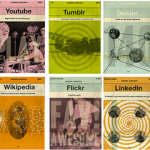 We are willingly feeding Twitter, Facebook, YouTube and various other social networking sites personal information that if analyzed and manipulated properly, can provide extremely powerful insights into any individual. I imagine that Twitter is only the beginning of data analysis for Klout and other companies alike. Imagine a tool not only knowing what topics you are most influential based on your tweets, but even where your favourite hangouts are from Foursquare, your favourite bands from Last.Fm, your job from LinkedIn and even who you are friends with from Facebook. Companies will be able to target each and every one of us to such a fine detail that it’s one part terrifying and one part fascinating. (On a side note, think about how CSIS and the FBI could use this information).
We are willingly feeding Twitter, Facebook, YouTube and various other social networking sites personal information that if analyzed and manipulated properly, can provide extremely powerful insights into any individual. I imagine that Twitter is only the beginning of data analysis for Klout and other companies alike. Imagine a tool not only knowing what topics you are most influential based on your tweets, but even where your favourite hangouts are from Foursquare, your favourite bands from Last.Fm, your job from LinkedIn and even who you are friends with from Facebook. Companies will be able to target each and every one of us to such a fine detail that it’s one part terrifying and one part fascinating. (On a side note, think about how CSIS and the FBI could use this information).
In the end, it was a small communication misstep that has caused so much customer service and PR grief for a 10 man technology startup. The email said “Because you have so much Klout”, which led us all to believe that it was cut and dry; if you have a high Klout score, then you get the free flight. Even with the blog post that followed, people had already stopped listening, started whining and it was too late. Perhaps if the email had said something along the lines of “you met our criteria”, Twitter might have been a whole lot quieter with the complaining. Wishful thinking right?
Even so, something so small will not break a company that is currently knee deep in such powerful data. I am confident that they will learn from their mistakes, and the attention will shift away from the customer service and free flights, and back to the actual metrics.

I want Klout to do well. From an obvious standpoint (according to their scale of 1 through 100, I am a decent influencer worthy of free prizes!), but more importantly from a social media and technological advancement perspective. The world is starting to appreciate Twitter, and finally realize the power and impact it can have. It seems like Marketing and PR agencies are just getting on the “blogger” wave, while Klout has already skipped past that and is on the new wave of 140 characters (or less).
Yes, it no longer requires a long 500-1,000 word blog post to influence people or to gain trust from your audience. If anything, I trust people on my Twitter feed more than I do a blog post; on Twitter, the person behind the account has no other option but to communicate and converse with their followers, while a blogger can stand up on a soap box, spew out hundreds of words, then sit and watch comments flow (or, trickle) in and approve or deny based on their preference. On Twitter, you get to see who does similar things as you, goes to similar places (yes those Foursquare check-in tweets are annoying, but it can tell you something about a person), and has similar interests. There are certain people who I follow on Twitter that may not have a blog (or I might feel weird emailing out of the blue), but I would look to them, just like I would look to a friend, for their opinion on something because I feel I have gotten to know them and I trust them.
Okay now this just seems like a Twitter love post. Back to Klout.
The thing about this campaign is, it successfully exploded, as they wanted it to. However, like many progressive campaigns, they may not have gotten all their ducks in a row that would prepare them to answer the inevitable questions that would arise regarding their grading system, and even more importantly, their Virgin America golden ticket winners. Now, I am not one to bite the hand that feeds (err flies) me, but I wouldn’t mind sharing a few things Klout may have wanted to consider before launching a high profile campaign (beyond free yogurt and coffee):
1. Iron out all the kinks in the Algorithm.
I received one of the first flights and I was made somewhat of a poster child for this program when Mashable contacted me about the ticket I was given, as well as for information on my Klout score. What they didn’t ask me was, “Is it accurate?”. To be honest, I wouldn’t even have known as I had never even looked before they asked me for the screenshots. Upon further review, I noticed the topics it told me I tweeted about most frequently were odd ones like ‘Voodoo’ (I ain’t no witch!), some of my apparently most clicked on tweets had never even come from my fingertips (and bit.ly tells me what my most popular links are, so this I know), and all-in-all my score seemed low relative to other people who didn’t receive flights immediately (apparently my score needed to be refreshed and recalculated and is now at a 63? Whatever that means, again I don’t know. By this point I probably should).
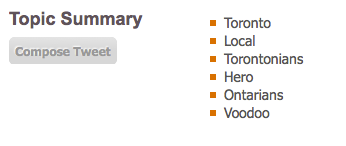
2. Be transparent on how the winners were selected.
If you are going to be the standard for determining who is an influencer, then you need to set a standard process for how winners are selected. Was it at random? Was it people who had a Klout account? Was it at random over a certain threshold? Hand selected – if so, based on what criteria? The people who win the ticket won’t ask these questions (although I am, I guess), but those who didn’t win certainly will.
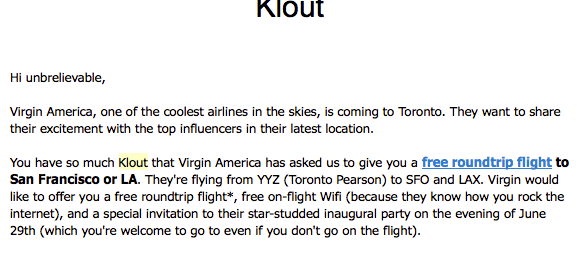
3. Know the community.
I don’t know about other communities, but the Toronto Twitter community is a pretty tight knit crew, and that crew is partially (if not fully) responsible for everyone’s “Twitter Influence”. I’m a bit of a floater, but I do know that most people in this city are friends on Twitter and in real life, and they have more influence because of this – their followers aren’t exactly followers at all, but friends, so of COURSE they have influence over them. Knowing this, it’s easy to see how people would get offended, or hurt even, if they are snubbed in a program in which they feel they are partially responsible for their friend winning. I even read one post which referred to the program as feeling like “high school” and “Mean Girls”. If you hear a Lindsay Lohan analogy for a marketing program, you know you might be in trouble! If number 2 happened, then I don’t think the “Mean Girls” comment would be able to come into play, as it would be based on a specific criteria, removing all room for apparent bias.
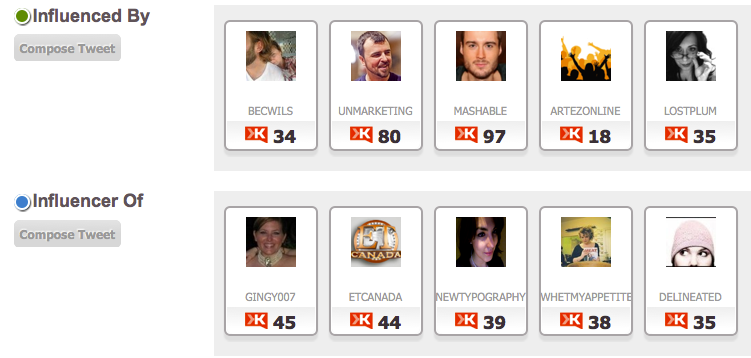
4. Have a cut off point.
This is a bit of column 2 and 3. The initial invites, for the most part (and I’m not just saying this because I was included) made sense. Celebrities People like Scott Stratten and Casie Stewart received invites and it made sense. Then, once the cries of “why didn’t I get one” came out, it seemed as though all you had to do was tweet the right hashtag or @ reply, and bam, you would magically see a tweet saying “I’m going to LA or SF, THANKS VIRGIN AND KLOUT”, and they would stop complaining. That’s when things got confusing, and a bit fishy. I saw people who had a Twitter account for maybe a month, and less than 200 followers receiving it, when well known Toronto personas weren’t seeing the love. This is when people started to question a) the validity of number 1 up there, and b) more importantly, number 2.
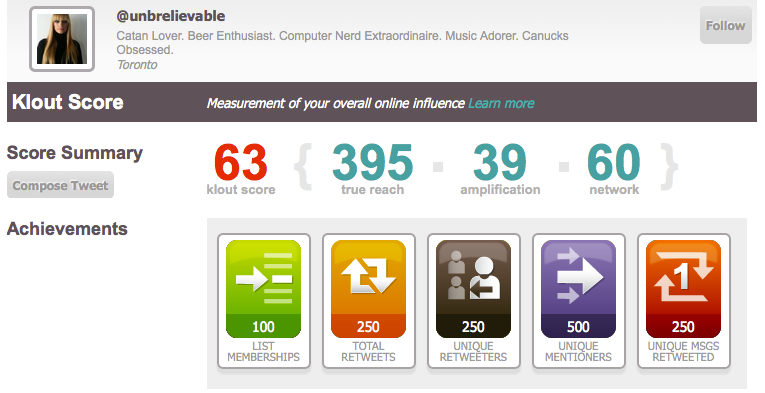
5. Use Hootsuite
Okay, so this is a bit of a weak one but I just noticed a flurry of retweets regarding a Klout meetup tonight at the Gladstone. The meetup has come and gone (it was last night). CoTweet scheduler is a bit wonky, so they should use my pals over at Hootsuite.
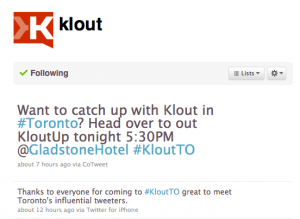
Despite the rough patches, I think there are a lot of valuable lessons learned from this program that will only help Klout be stronger and more successful going forward. The Toronto Twitter community is a tough crowd, and can be ruthless at times, but we can also be understanding. I’m excited to visit Klout while I am in San Francisco this coming weekend (on a FREE FLIGHT), and I will be sure to share some of the constructive feedback that I have here, and also that I have heard from others. In the end, I think we all really do (or SHOULD!) want Klout to succeed, and I think any help we can offer will benefit them.

 All marketing campaigns have a target demographic as determined by the client. In this case it was Virgin America and they wanted people who not only had influence, but were aligned with their brand and this particular campaign. Klout was the tool that took the data we pump daily into Twitter (think of all that data!) and used it to categorize and profile each and everyone one of us, allowing their client to pick and choose what type of person would be given a flight. Yes, the client wanted ‘influencers’ (anyone else hate that word yet?), but they also wanted people who spoke about the various destinations, among many other variables that they deemed important. Normally, it is rare that the target demographic for a campaign is so heavily questioned, but when dealing with a large number of users who like to talk a lot, it’s more than likely to be put under the microscope and heavily scrutinized.
All marketing campaigns have a target demographic as determined by the client. In this case it was Virgin America and they wanted people who not only had influence, but were aligned with their brand and this particular campaign. Klout was the tool that took the data we pump daily into Twitter (think of all that data!) and used it to categorize and profile each and everyone one of us, allowing their client to pick and choose what type of person would be given a flight. Yes, the client wanted ‘influencers’ (anyone else hate that word yet?), but they also wanted people who spoke about the various destinations, among many other variables that they deemed important. Normally, it is rare that the target demographic for a campaign is so heavily questioned, but when dealing with a large number of users who like to talk a lot, it’s more than likely to be put under the microscope and heavily scrutinized. Klout started off with an initial shortlist of hand picked users who had not only had high Klout scores, but that additional X-factor, if you will. From that list, it became a word of mouth trickle-down effect. They watched for people the original round of influencers were speaking to, and about. So really, it wasn’t just about the Klout score, or how influential each person was, it was a word of mouth marketing campaign. Sure, talking to or about Klout itself might have helped you get noticed, but once noticed, if you didn’t fit the criteria that the client deemed important, then you weren’t selected.
Klout started off with an initial shortlist of hand picked users who had not only had high Klout scores, but that additional X-factor, if you will. From that list, it became a word of mouth trickle-down effect. They watched for people the original round of influencers were speaking to, and about. So really, it wasn’t just about the Klout score, or how influential each person was, it was a word of mouth marketing campaign. Sure, talking to or about Klout itself might have helped you get noticed, but once noticed, if you didn’t fit the criteria that the client deemed important, then you weren’t selected. After speaking with Klout it really became apparent to me that they were as transparent as they possibly could be, without putting themselves in competitive risk. Gregarious Narain, the VP of Product, put it best when he said “we are an iceberg”; the scores and summaries we see are just the surface of the data analysis and manipulation that goes on behind the scenes. The Content Analysis from our profiles are not specific keywords that we speak of, but categories in which these tags are grouped into. Furthermore, they are the most influential categories; so it’s not just what we say but more about what resonates with others. Klout puts a heavy emphasis on the limited focus it has on followers and following count, but more on what happens in each and every interaction.
After speaking with Klout it really became apparent to me that they were as transparent as they possibly could be, without putting themselves in competitive risk. Gregarious Narain, the VP of Product, put it best when he said “we are an iceberg”; the scores and summaries we see are just the surface of the data analysis and manipulation that goes on behind the scenes. The Content Analysis from our profiles are not specific keywords that we speak of, but categories in which these tags are grouped into. Furthermore, they are the most influential categories; so it’s not just what we say but more about what resonates with others. Klout puts a heavy emphasis on the limited focus it has on followers and following count, but more on what happens in each and every interaction. We are willingly feeding Twitter, Facebook, YouTube and various other social networking sites personal information that if analyzed and manipulated properly, can provide extremely powerful insights into any individual. I imagine that Twitter is only the beginning of data analysis for Klout and other companies alike. Imagine a tool not only knowing what topics you are most influential based on your tweets, but even where your favourite hangouts are from Foursquare, your favourite bands from Last.Fm, your job from LinkedIn and even who you are friends with from Facebook. Companies will be able to target each and every one of us to such a fine detail that it’s one part terrifying and one part fascinating. (On a side note, think about how CSIS and the FBI could use this information).
We are willingly feeding Twitter, Facebook, YouTube and various other social networking sites personal information that if analyzed and manipulated properly, can provide extremely powerful insights into any individual. I imagine that Twitter is only the beginning of data analysis for Klout and other companies alike. Imagine a tool not only knowing what topics you are most influential based on your tweets, but even where your favourite hangouts are from Foursquare, your favourite bands from Last.Fm, your job from LinkedIn and even who you are friends with from Facebook. Companies will be able to target each and every one of us to such a fine detail that it’s one part terrifying and one part fascinating. (On a side note, think about how CSIS and the FBI could use this information).






